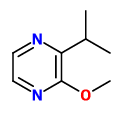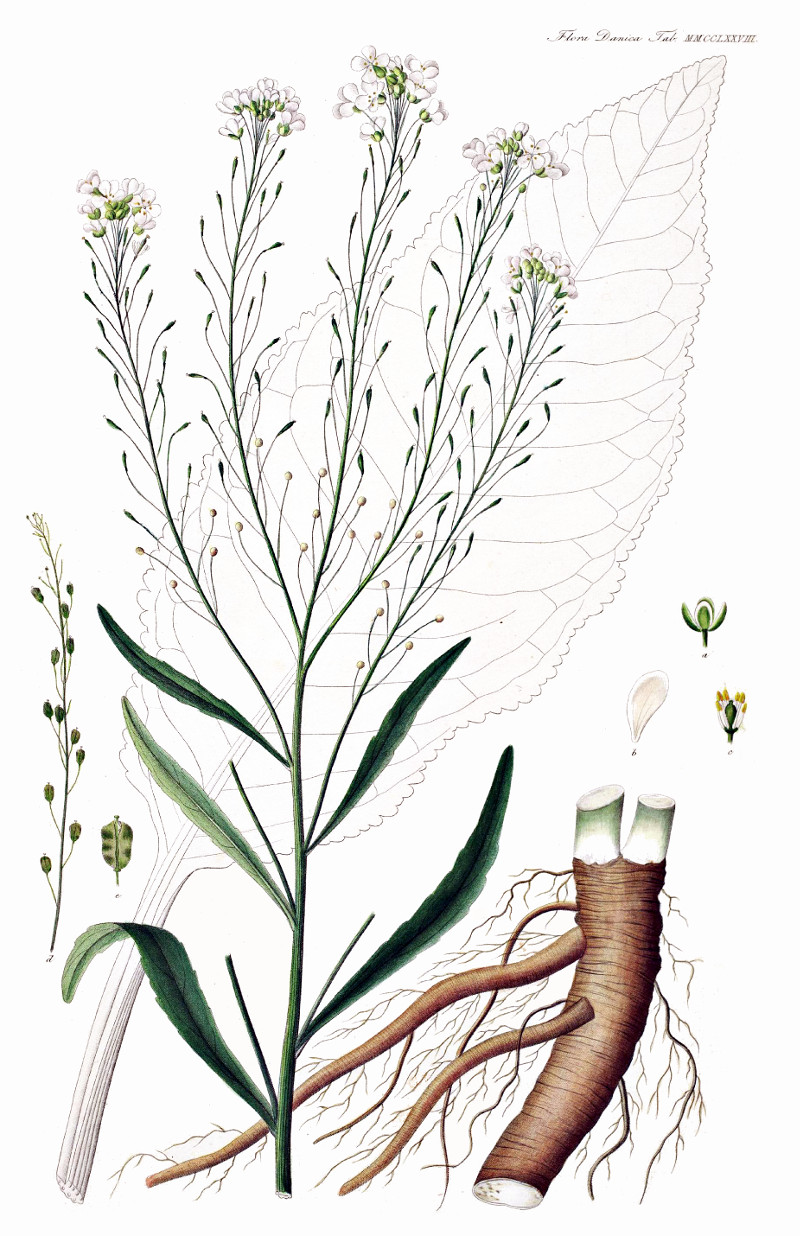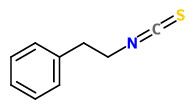Benutzer-Werkzeuge
Armoracia rusticana G.Gaertn., B.Mey. & Scherb. - syn.Armoracia sativa Bernh., Armoracia lapathifolia Gilib. ex Usteri, Cochlearia armoracia L., Cochlearia rusticana Lam., Nasturtium armaracia Fries - Brassicaceae
horseradish, Meerrettich, Kren
Erect perennial herb, 0.40-1.20m high, native to eastern Europe, naturalized in Europe, North America, cultivated in Europe, North America; taproot thick and very deep; basal leaves long-petioled, oblong, pale green, 0.30-1m long, notched; the hollow stem developes later, with short stalked, lanceolate, leaves; tiny white flowers produced in terminal racemes.
„Essences of the volatile components of five samples of horseradish root, three fresh and two of dried flakes, have been prepared and examined by gas chromatography (g.c.) and combined gas chromatography-mass spectrometry (g.c.-m.s.). At least 17 compounds are involved. Five of these have been rigorously identified by comparison with authentic compounds, synthesised where necessary, through mass spectra and retention data and the identities of three others have been tentatively established. The compounds concerned are methyl, ethyl, isopropyl, 2-butyl, allyl, 4-pentenyl and 2-phenethyl isothiocyanate and allyl thiocyanate. The constituents of the five essences were assessed semi-quantitatively by g.c. and definite differences found. These were reinforced by examination of the headspace vapours over the coarsely grated root.“
[Volatile constituents of horseradish roots., Gilbert, J., Nursten, H. E., Journal of the Science of Food and Agriculture, Vol.23(4), 1972, 527-539]
„… AITC [allylisothiocyanate] was the primary contributor into total ITC [isothiocyanate] concentration of wasabi (94%) and horseradish (87%) and this suggests it will provide the most important character to the total flavour profile in both…
The differences in the flavour between wasabi and horseradish depend on differences in the flavour compounds, which occur in the two plants. 2-phenylethyl ITC was the accept biggest component after AITC and was detected only in horseradish. It is likely to have a significant role in the overall aroma and taste profile of horseradish. Gilbert & Nursten, (1972) suggested that a small change in the proportions of ITCs would be sufficient to significantly alter the overall aroma. As a consequence, 2-phenylethyl ITC may play a major role in distinguishing the flavour profile of horseradish from wasabi. Masuda et al. (1996) and Gilbert & Nursten, (1972) reported that 2-PEITC imparted a strongly radish-like, fresh watercress aroma and gave a tingly sensation to the mouth. However, 2-PEITC had no pungency and lachrymatory role at all, like AITC, and therefore was distinctively different from AITC. Masuda et al. (1996) suggest that 2-PEITC was responsible for the obvious difference in odour between wasabi and horseradish. Hence the analytical and organoleptic
data are consistent in attributing the radish-like aroma in horseradish to the contribution of 2-PEITC.“
[Comparison of flavour compounds in wasabi and horseradish., Sultana, T., Savage, G. P., McNeil, D. L., Porter, N. G., Clark, B., Journal of Food Agriculture & Environment, Vol.1(2), 2003, 117-121] http://www.coppersfolly.co.nz/v1/research/comparison2.pdf
„Horseradish is a perennial plant with significant antioxidant properties, and it contains about 0.2% to 1.0% of essential oil, mainly sinigrin, sinigrin-derived allylisothiocyanate and diallylsulphide. The aim of the study was to determine composition of volatile compounds of horseradish (A. rusticana L.) roots depending on the genotype. Volatiles from fresh horseradish roots of nine genotypes were extracted using solid phase microextraction with DVB/Car/PDMS fibre and were further analysed using gas chromatography-mass spectrometry. The volatile compounds were identified by comparing their mass spectra with mass spectral libraries (Nist98) and by calculating linear retention indexes and comparing them with the literature data. The studied horseradish genotypes differed both in the quantitative and qualitative content of aroma compounds. Totally 15 volatile compounds were detected, and their highest amount was found in genotype G12B. The main aroma compound of all horseradish samples was allylisothiocyanate, which formed 64-82% of the total identified volatile compounds. The obtained results were compared with those found in the literature. All horseradish samples contained significant amounts of phenylethylisothiocyanate (4-18%) that is formed from glucosinolate - gluconasturtin. The study revealed that genotype has great influence on the content of volatiles in horseradish roots.“
[Composition of volatile compounds of horseradish roots (Armoracia rusticana L.) depending on the genotype. Tomsone, L., Kruma, Z., Galoburda, R., Talou, T., Proceedings of the Latvia University of Agriculture, Vol.29(1), 2013, 1-10]
„The antimicrobial activity of isothiocyanates (ITCs) extracted from horseradish root was investigated against oral microorganisms: 6 strains of facultative anaerobic bacteria, Streptococcus mutans, Streptococcus sobrinus, Lactobacillus casei, Staphylococcus aureus, Enterococcus faecalis and Aggregatibacter actinomycetemcomitans; one strain of yeast, Candida albicans, and 3 strains of anaerobic bacteria, Fusobacterium nucleatum, Prevotella nigrescens, and Clostridium perfringens. The ITCs extracted from horseradish root showed antimicrobial activity against all oral microorganisms by the paper disk method. The minimum bactericidal concentration (MBC) of the ITCs extracted from horseradish root ranged from 1.25 to 5.00 mg/ml against 6 strains of facultative anaerobic bacteria and one strain of yeast, and 4.17 to 16.67 mg/ml against 3 strains of anaerobic bacteria. The ITCs extracted from horseradish root showed the strongest antimicrobial activity, with a MBC of 1.25 mg/ml, against C. albicans among facultative microorganisms, and 4.17 mg/ml against F. nucleatum among anaerobic bacteria. These results suggest that the ITCs extracted from horseradish root may be a candidate for use as an antimicrobial agent against oral microorganisms.“
[Antimicrobial Activity of Isothiocyanates (ITCs) Extracted from Horseradish (Armoracia rusticana) Root against Oral Microorganisms., Park, H. W., Choi, K. D., Shin, I. S., Biocontrol science, Vol.18(3), 2013, 163-168]
 3-isopropyl-2-methoxypyrazine (green pea earthy) |  (3S,3aS,7aR)-wine lactone intense sweet coconut-like (coumarinic) |
Of 45 aroma-active compounds detected by GC-O, (3S,3aS,7aR)-wine lactone and 3-isopropyl-2-methoxypyrazine were the most potent.
[Kroener, Eva-Maria, and Andrea Buettner. „Unravelling important odorants in horseradish (Armoracia rusticana).“ Food chemistry 232 (2017): 455-465]
„Horseradish extracts were analyzed through gas chromatography-olfactometry (GC-O) and their aroma-active compounds ranked according to their smell potency using the concept of aroma extract dilution analysis (AEDA)… Besides some differences in relative ratios, we observed some main odorants that were common to all varieties such as 3-isopropyl-2-methoxypyrazine and allyl isothiocyanate, but also characteristics for specific varieties such as higher contents for 3-isopropyl-2-methoxypyrazine in variety Nyehemes… Substances found with overall high FD factors in all samples were the pungent, mustard-, horseradish- and onion-like smelling AITC (FD 1024-2048), the horseradish-like, pungent, watercress-like smelling PEITC (FD 64-2048), the grassy, green smelling (Z)-3-hexenal (FD 32-512), the green pepper-like smelling pyrazines 3-isopropyl-2-methoxypyrazine (FD 1024-8192) and 3-sec-butyl-2-methoxypyrazine (FD 32-256). Apart from that, we detected skatole (FD 16-64), which gives a fecal odor impression, and the sweet, smoky, peach- and coconut-like smelling (3S,3aS,7aR)-wine lactone (FD 512-2048). In our previous study (Kroener and Buettner, 2017), (3S,3aS,7aR)-wine lactone could only be tentatively identified, whereas in this study we were now able to obtain a mass spectrum of this compound which matched with the MS spectrum of the (3S,3aS,7aR)-wine lactone standard.“
[Kroener, Eva-Maria, and Andrea Buettner. „Sensory-analytical comparison of the aroma of different horseradish varieties (Armoracia rusticana).“ Frontiers in Chemistry 6 (2018): 149] https://www.ncbi.nlm.nih.gov/pmc/articles/PMC5949313/

G.C.Oeder et al., Flora Danica, f.47, t.2778 (1761-1883)
http://plantgenera.org/species.php?id_species=89564
Armoracia rusticana © Rolf Marschner (2007),
www.botanische-spaziergaenge.at


